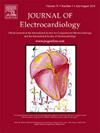An in-silico analysis of the influence of left bundle branch block and myocardial fibrosis on electrocardiographic QRS duration and morphology and vectorcardiographic QRS area
IF 1.2
4区 医学
Q3 CARDIAC & CARDIOVASCULAR SYSTEMS
引用次数: 0
Abstract
Background and aims
Vectorcardiographic (VCG) QRS area has shown great promise as a predictor of cardiac resynchronization therapy outcomes. However, underlying conduction factors influencing the genesis of QRS area and its relationship with myocardial fibrosis remain unexplored. This study aimed to investigate the impact of left bundle branch block (LBBB) and fibrosis on QRS duration and morphology in comparison to QRS area through an in-silico analysis.
Methods
ECGsim was used to simulate four scenarios: normal ventricular activation without (1) and with fibrosis (2), and LBBB without (3) and with (4) fibrosis. Conduction patterns were modified to represent LBBB, while regional conductivity was modified to model focal fibrosis. 12‑lead electrocardiograms and reconstructed VCGs were used to calculate QRS duration and area, and to assess QRS morphology.
Results
Myocardial fibrosis induced slight QRS notching during normal ventricular activation, but did not alter QRS morphology during LBBB activation. Furthermore, inducing regional fibrosis during normal ventricular activation hardly changed QRS duration (90 to 96 ms), while QRS area slightly decreased (37 to 32 mV.ms). LBBB without fibrosis increased QRS area compared to normal ventricular activation (90 to 145 mV.ms). Notably, inducing fibrosis in the LBBB scenario had little effect on QRS duration (145 to 142 ms) but significantly reduced QRS area (146 to 105 mV.ms).
Conclusion
A LBBB activation, and not myocardial fibrosis, induces a large QRS area. In the presence of LBBB, myocardial fibrosis cannot be clearly identified with QRS morphology and has a limited effect on QRS duration but significantly reduces QRS area.

左束支阻滞和心肌纤维化对心电图QRS持续时间、形态及矢量心动图QRS面积影响的计算机分析
背景与目的心电图(VCG) QRS区域作为心脏再同步化治疗结果的预测指标显示出很大的前景。然而,影响QRS区发生的潜在传导因子及其与心肌纤维化的关系尚不清楚。本研究旨在通过计算机分析,探讨左束分支阻滞(LBBB)和纤维化对QRS持续时间和形态的影响,并与QRS面积进行比较。方法采用secgsim模拟4种情况:无(1)和纤维化(2)的正常心室激活,无(3)和纤维化(4)的LBBB。传导模式被修改为代表LBBB,而区域传导模式被修改为模拟局灶性纤维化。采用12导联心电图和重建vcg计算QRS持续时间和面积,并评估QRS形态学。结果心肌纤维化在正常心室激活时引起轻微的QRS缺口,但在LBBB激活时不改变QRS形态。此外,在正常心室激活时诱导区域纤维化几乎没有改变QRS持续时间(90 ~ 96 ms),而QRS面积略有减少(37 ~ 32 mV.ms)。与正常心室激活(90 ~ 145 mV.ms)相比,无纤维化的LBBB增加了QRS面积。值得注意的是,在LBBB情况下诱导纤维化对QRS持续时间(145至142 ms)影响不大,但显著减少QRS面积(146至105 mV.ms)。结论LBBB激活引起大QRS区,而非心肌纤维化。LBBB存在时,心肌纤维化不能通过QRS形态学清晰识别,对QRS持续时间影响有限,但QRS面积明显减少。
本文章由计算机程序翻译,如有差异,请以英文原文为准。
求助全文
约1分钟内获得全文
求助全文
来源期刊

Journal of electrocardiology
医学-心血管系统
CiteScore
2.70
自引率
7.70%
发文量
152
审稿时长
38 days
期刊介绍:
The Journal of Electrocardiology is devoted exclusively to clinical and experimental studies of the electrical activities of the heart. It seeks to contribute significantly to the accuracy of diagnosis and prognosis and the effective treatment, prevention, or delay of heart disease. Editorial contents include electrocardiography, vectorcardiography, arrhythmias, membrane action potential, cardiac pacing, monitoring defibrillation, instrumentation, drug effects, and computer applications.
 求助内容:
求助内容: 应助结果提醒方式:
应助结果提醒方式:


